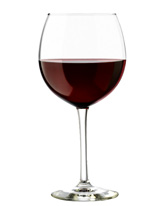Merlot
 Merlot is a versatile red wine with soft tannins, lucious deep flavors and a velvety texture. Merlot varietal wines usually have medium body with hints of berry, plum, black cherry, raspberry or currant. It requires less cellaring than wines with harsh tannins, so it can be consumed young. Hugely popular some time back, Merlot lost some of its following when the movie Sideways scoffed Merlot as an inferior wine. Those who make up their own minds about wine, however, very much enjoy a well-made Merlot. Check out our video, here, on the merits of Merlot from a knowledgable winemaker.
Merlot is a versatile red wine with soft tannins, lucious deep flavors and a velvety texture. Merlot varietal wines usually have medium body with hints of berry, plum, black cherry, raspberry or currant. It requires less cellaring than wines with harsh tannins, so it can be consumed young. Hugely popular some time back, Merlot lost some of its following when the movie Sideways scoffed Merlot as an inferior wine. Those who make up their own minds about wine, however, very much enjoy a well-made Merlot. Check out our video, here, on the merits of Merlot from a knowledgable winemaker.
Merlot Wine Grapes
Merlot is used as both a blending grape and for varietal wines. Merlot grapes are grown around the world, mostly in the cooler regions, but the grape is chiefly associated with the Bordeaux region of France, in particular, the “Right Bank” (including St. Emilion and Pomerol) where the wines are dominated by Merlot. Along with Cabernet Sauvignon, Cabernet Franc, Malbec and Petit Verdot, Merlot is one of the primary grapes in Bordeaux wine where it is the most widely planted grape.

Merlot is also very popular in northern Italy and the warmer southern regions of Switzerland. In the United States, Merlot was widely planted in the late 1980’s and early 1990’s, especially in California and Washington on the country’s west coast. Chile has also built a reputation for very good Merlot-based wines.
Tasting Merlot
The tremendously broad range of bouquets, flavors, textures and impressions that Merlot can produce sometimes confuses tasters.
In the broadest terms, the wine tends to be of light to medium body with an aroma reminiscent of black cherry, raspberry or currant. Traditional red Burgundy is famous for its fleshy, ‘farmyard’ aromas, but changing fashions and new easier-to-grow clones have favoured a lighter, fruitier style.
The Merlot grape’s color when young, often compared to that of garnet, is generally much lighter than that of other red wines. However, an emerging style from California and New Zealand highlights a more powerful, fruit forward and darker wine that can approach syrah in depth.
VIDEO
Silver Oak and Twomey Winemaker Daniel Baron and Wine Specialist Joe Roberts discuss the varietal merlot and its comeback in the market. See why Daniel says, “It’s a beautiful wine.”
More about Merlot wines:
Check out our MERLOT Wine Tasting Forum
Styles of Merlot
There are three main styles of Merlot:
- a soft, fruity, smooth wine with very little tannins,
- a fruity wine with more tannic structure,
- a brawny, highly tannic style made in the profile of Cabernet Sauvignon.
Some of the fruit notes commonly associated with Merlot include cassis, black and red cherries, blackberry, blueberry, boysenberry, mulberry, ollalieberry and plum. Vegetable and earthy notes include black and green olives, cola nut, bell pepper, fennel, humus, leather, mushrooms, rhubarb and tobacco. Floral and herbal notes commonly associated with Merlot include green and black tea, eucalyptus, laurel, mint, oregano, pine, rosemary, sage, sarsaparilla and thyme. When Merlot has spent significant time in oak, the wine may show notes of caramel, chocolate, coconut, coffee bean, dill weed, mocha, molasses, smoke, vanilla and walnut.
Food & Merlot Wine Pairings
Merlot is an amazingly food-friendly wine. It is very good with grilled burgers, steaks, roast chicken or other poultry and grilled meats, but actually goes well with most foods. It also pairs very well with with tomato-based pasta sauces and is amazing with grilled lamb chops. Avoid serving Merlot with fish and pork.
As for cheese, either cheddar (or other similar sharp “English” cheese) or Blue cheeses (Stilton, Danish Blue, Roquefort) are an excellent pairing.
Alternatives to Merlot? In a pinch, consider Zinfandel if you are looking for a big red flavor or Syrah for something lighter.
Cheers!
